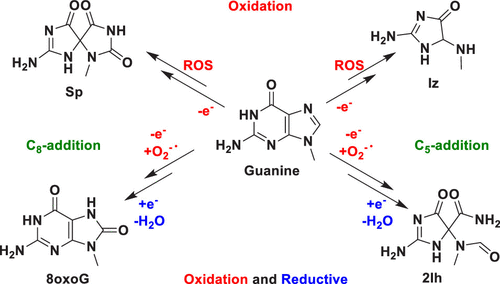当前位置:
X-MOL 学术
›
Chem. Res. Toxicol.
›
论文详情
Our official English website, www.x-mol.net, welcomes your
feedback! (Note: you will need to create a separate account there.)
Computational Study of the Oxidation of Guanine To Form 5-Carboxyamido-5-formamido-2-iminohydantoin (2Ih).
Chemical Research in Toxicology ( IF 3.7 ) Pub Date : 2019-10-15 , DOI: 10.1021/acs.chemrestox.9b00304
Sebastien P Hebert 1 , H Bernhard Schlegel 1
Chemical Research in Toxicology ( IF 3.7 ) Pub Date : 2019-10-15 , DOI: 10.1021/acs.chemrestox.9b00304
Sebastien P Hebert 1 , H Bernhard Schlegel 1
Affiliation

|
Oxidative damage to DNA leads to a number of two-electron oxidation products of guanine such as 8-oxo-7,8-dihydroguanine (8oxoG). 5-Carboxyamido-5-formamido-2-iminohydantoin (2Ih) is another two-electron oxidation product that forms in competition with 8oxoG. The pathways for the formation of 2Ih have been studied by density functional theory using the ωB97XD functional with the 6-31+G(d,p) basis set and SMD implicit water solvation plus a small number of explicit water molecules positioned to help stabilize charged species and facilitate reaction steps. For oxidative conditions that produce hydroxyl radical, such as Fenton chemistry, hydroxy radical can add at C4, C5, or C8. Addition at C4 or C5 followed by loss of H2O produces guanine radical. Guanine radical can also be produced directly by oxidation of guanine by reactive oxygen species (ROS). A C5-OH intermediate can be formed by addition of superoxide to C5 of guanine radical followed by reduction. Alternatively, the C5-OH intermediate can be formed by hydroxy radical addition at C5 and oxidation by 3O2. The competition between oxidative and reductive pathways depends on the reaction conditions. Acyl migration of the C5-OH intermediate yields reduced spiroiminodihydantoin (Spred). Subsequent water addition at C8 of Spred and N7-C8 ring opening produces 2Ih. Hydroxy radical addition at C8 can lead to a number of products. Oxidation and tautomerization produces 8oxoG. Alternatively, addition of superoxide at C5 and reduction results in a C5, C8 dihydroxy intermediate. For this species, the low energy pathway to 2Ih is N7-C8 ring opening followed by acyl migration. Ring opening occurs more easily at C8-N9 but leads to a higher energy analogue of 2Ih. Thus, the dominant pathway for the production of 2Ih depends on the nature of the reactive oxygen species and on the presence or absence of reducing agents.
中文翻译:

鸟嘌呤氧化形成5-羧酰氨基-5-甲酰氨基-2-亚氨基乙内酰脲(2Ih)的计算研究。
对DNA的氧化损伤会导致许多鸟嘌呤的双电子氧化产物,例如8-oxo-7,8-dihydroguanine(8oxoG)。5-羧酰胺基-5-甲酰胺基-2-亚氨基乙内酰脲(2Ih)是另一种与8oxoG竞争形成的两电子氧化产物。密度泛函理论已研究了使用6-31 + G(d,p)基组的ωB97XD官能团和SMD隐式水溶剂化以及少量定位以帮助稳定带电的显式水分子的2Ih形成途径。并促进反应步骤。对于产生羟基自由基的氧化条件,例如Fenton化学,羟基自由基可以在C4,C5或C8处添加。在C4或C5处添加,随后损失H 2 O产生鸟嘌呤基团。鸟嘌呤自由基也可以通过鸟嘌呤被活性氧(ROS)氧化而直接产生。可以通过将超氧化物添加到鸟嘌呤基团的C5中然后还原来形成C5-OH中间体。或者,可以通过在C5处加入羟基自由基并通过3O2氧化来形成C5-OH中间体。氧化和还原途径之间的竞争取决于反应条件。C5-OH中间体的酰基迁移可减少螺旋藻二乙内酰脲(Spred)。随后在Spred的C8和N7-C8开环处加水,将产生2Ih。C8处的羟基自由基加成会导致产生许多产物。氧化和互变异构产生8oxoG。或者,在C5处加入超氧化物并还原得到C5,C8二羟基中间体。对于此物种,通向2Ih的低能途径是N7-C8开环,然后进行酰基迁移。开环在C8-N9处更容易发生,但导致2Ih的更高能量类似物。因此,产生2Ih的主要途径取决于活性氧种类的性质以及还原剂的存在与否。
更新日期:2019-10-16
中文翻译:

鸟嘌呤氧化形成5-羧酰氨基-5-甲酰氨基-2-亚氨基乙内酰脲(2Ih)的计算研究。
对DNA的氧化损伤会导致许多鸟嘌呤的双电子氧化产物,例如8-oxo-7,8-dihydroguanine(8oxoG)。5-羧酰胺基-5-甲酰胺基-2-亚氨基乙内酰脲(2Ih)是另一种与8oxoG竞争形成的两电子氧化产物。密度泛函理论已研究了使用6-31 + G(d,p)基组的ωB97XD官能团和SMD隐式水溶剂化以及少量定位以帮助稳定带电的显式水分子的2Ih形成途径。并促进反应步骤。对于产生羟基自由基的氧化条件,例如Fenton化学,羟基自由基可以在C4,C5或C8处添加。在C4或C5处添加,随后损失H 2 O产生鸟嘌呤基团。鸟嘌呤自由基也可以通过鸟嘌呤被活性氧(ROS)氧化而直接产生。可以通过将超氧化物添加到鸟嘌呤基团的C5中然后还原来形成C5-OH中间体。或者,可以通过在C5处加入羟基自由基并通过3O2氧化来形成C5-OH中间体。氧化和还原途径之间的竞争取决于反应条件。C5-OH中间体的酰基迁移可减少螺旋藻二乙内酰脲(Spred)。随后在Spred的C8和N7-C8开环处加水,将产生2Ih。C8处的羟基自由基加成会导致产生许多产物。氧化和互变异构产生8oxoG。或者,在C5处加入超氧化物并还原得到C5,C8二羟基中间体。对于此物种,通向2Ih的低能途径是N7-C8开环,然后进行酰基迁移。开环在C8-N9处更容易发生,但导致2Ih的更高能量类似物。因此,产生2Ih的主要途径取决于活性氧种类的性质以及还原剂的存在与否。































 京公网安备 11010802027423号
京公网安备 11010802027423号